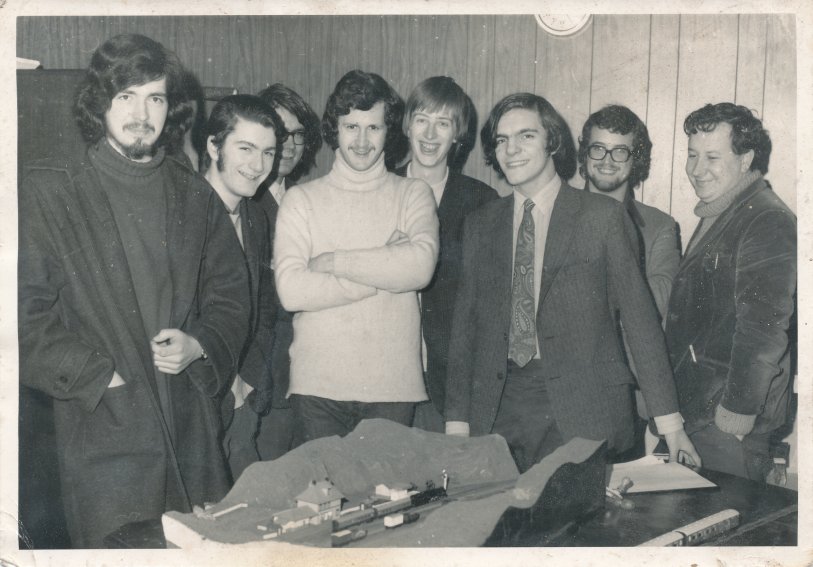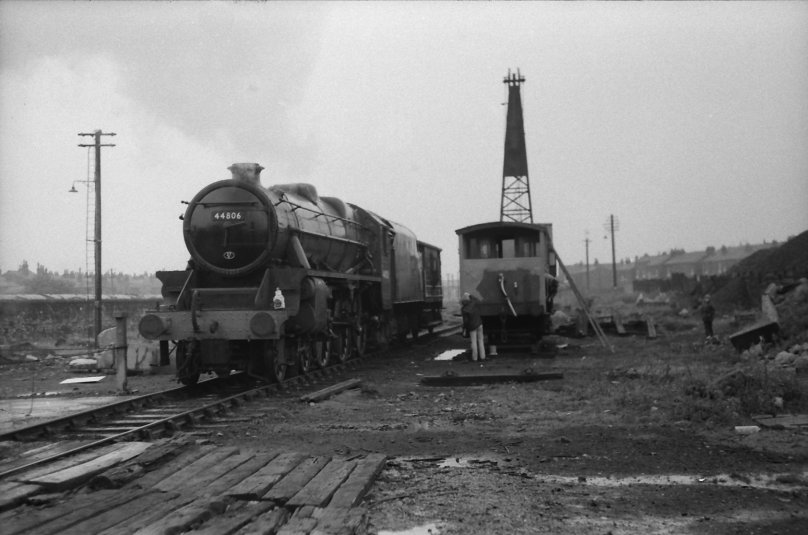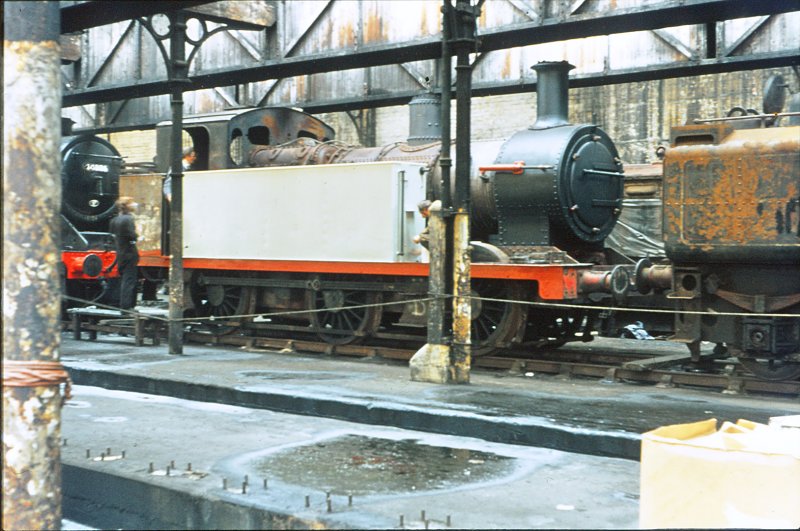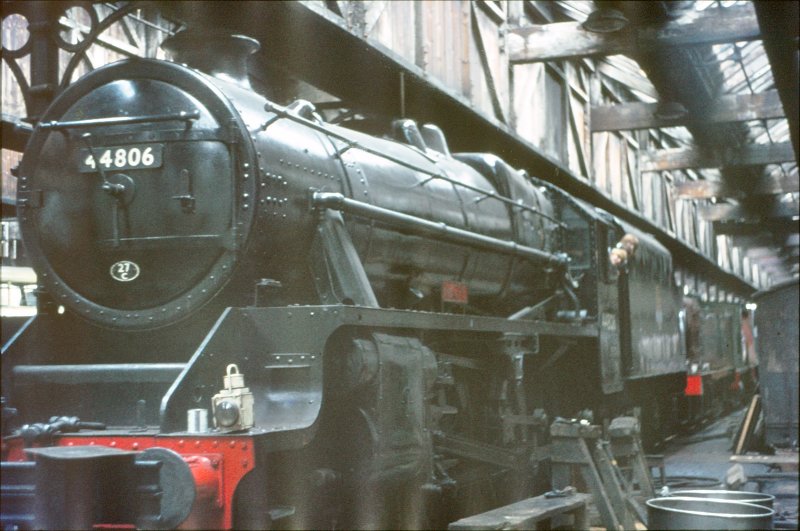
Steamport Southport Model Railway Club
The Ribble Steam Centre is a well-developed museum and workshop resource located in Preston. But its origins were in Southport, where a transport museum was set-up in the old locomotive depot on Derby Road in the 1970s, branded 'Steamport Southport'. As there were a surfeit of large rooms, it made perfect sense to have a model railway club that could support the wider objectives of the museum.When Southport had a transport museum located in the old locomotive depot on Derby Road in the 1970s, it made perfect sense to have a model railway club that could support the wider objectives of the museum.
The 'club' initially met at premises off Liverpool Road in Birkdale, before one of the old offices at Derby Road was rehabilitated. This snap catches a Friday clubnight in October 1971 and the photographer from the Southport Visiter has turned-up to record the event.
In the foreground is an N scale layout loaned by Nick Wood, based on the Crianlarich (Caledonian not West Highland) track plan, but presented as a terminus. Charles Box who wrote a very comprehensive history of the Liverpool Overhead Railway (his father was the General Manager of the LOR) was also a member of the group, and he also donated three baseboards he had had made for a 7mm scale Liverpool Overhead Railway layout based on Dingle which sadly did not get built, although he had a 3-car train built for it.
Ultimately Allan Needham, who then owned Formby Electrical, bank rolled the group, generously provided baseboards and track for the first layout, which was exhibited in Bolton and in Southport.
Inevitably the conflicting interests (museum v. modelling) led to the formation of the current Southport Model Railway Society that meets in the old station building alongside the Liverpool-Southport line at Portland Street.

Photo courtesy of Trinity Mirror plc
From left to right we have: Keith Wallace, Jonathan Wray, Tom Bell, Phil Kirby, Phil Mouldycliff, Barry Turner, Nick Wood and Chris Grey.
I'm pleased to report that Phil, Tom, Nick and Jonathan are still keen modellers. Jonathan was until recently the Press Officer for the LNER Society, and Tom Bell is a 3D specialist supplier in Narrow Gauge prototypes: and very nice they look to. Check out his TB Mobels online shop. Nick is the only member to have had a layout featured as 'Railway of the Month', which appeared in the August 2016 issue of the 'Railway Modeller'. Nick's very atmospheric 'Bodmin and Wadebridge Railway' can be seen here.

Copyright J K Wallace, c. 2014, all rights reserved. Photographer unknown
The model railway club occupied the old Offices at the rear of the shed. This is a historically interesting shot taken at the 'business' end.
It shows Black 5 44806, which had arrived from the Lakeside Railway requiring firebox repairs, and was delivered unsteamable and 'out of ticket'.
However, a welder was found to patch the crack, allowing the loco to be steamed just once at Steamport. As an uncoded welder had been employed, insurance was out of the question, and so the brave effort to procure a working main line loco for the fledgling museum failed. However, the photograph clearly shows 44806 in steam, and therefore records this 'once only' event.
Two LMS brake vans had been acquired, and both are in view. The one on the short siding which will form road 2 is in front of a self-propelled crane that was one of the first rail vehicles on site. The vans are now in warm and safe storage at the Ribble Steam Railway. At this time only one road had been relaid. The shed roads required L1 square chairs, and Martin Lee spent much time locating these chairs, one or two at a time, until the end of the shed was reached. Ahead of 44806, inside the shed on road 3, would have been the two Liverpool Locomotive Preservation Group's industrial tanks 'Lucy' and 'Efficient'.
44806 had originally been preserved at Carnforth, and as part of the efforts to break away from historically correct LMS and BR black, various locos had been painted in liveries that would have been seen at Carnforth over the years, although not on the locos, or the classes, involved. 44806 was one the less-bad matches, as it was painted in BR green with early emblem. It was in this form that it arrived at Steamport. It had been named 'Magpie' at Lakeside after ITV's attempt to rival 'Blue Peter', and the programme had visited the railway and filmed the loco being named. I didn't see the name plates in situ, although the brackets were in place on arrival.
Gordon Walker, as Chairman of Steamport, wasn't a fan of contrived liveries, and took a week off work to repaint 44806 in black. He carefully painted round the BR emblem on the tender, which worked quite well.
Having been steamed the once, and not having the engineering resources or finance to lift the boiler, the loco became a static exhibit. Finally it was moved to the Llangollen Railway, where the firebox repairs were undertaken.
In the left foreground, the concrete apron that ran the full width of the shed can be seen. Unfortunately when the track was removed after closure, the chairs had been pulled off the studs, which in turn were unusable. So the decision was taken to break up this apron with hand tools. It was a great act of faith by the volunteer labour force that this apron was cleared from the front of the shed for roads 1 to 3 when there was little prospect of any track in the near future.
Achieving a connection to the main line was a problem, as BR produced an estimate for a connection that was unaffordable. Marin Lee hit on the idea of renting the siding on the other side of the wall with the goods station, and then slewing the track over at the St Lukes end of the site onto the Steamport site, so that BR didn't have to actually do anything. This worked a treat, and in due course the track made its way across the yard and to the shed, as the photo shows.
Behind the telegraph/lighting pole in the left background can be see the boundary wall, on the other side of which was Derby Road goods yard. Just over the wall can be seen a row of coach roofs. These are three surplus centre trailer cars from Class 502 Liverpool - Southport electric sets, which were being withdrawn at the time. The local youth had prized open some of the sliding doors - on the side away from the houses - and were using the emergency ladders stored under the cars to access the interiors. When the preserved 502 came to Steamport, permission was given for spares to be removed from the trailers.
On the right can be seen the coal stocks held in the domestic fuel depot. St Lukes signal box was located just beyond the end of the sleeper fence. Its location could be identified at this time, as in the yard was a stop cock. By turning the tap, a jet of water would shoot up about 20 feet towards the running lines. This was the live water feed for the elevated cabin.
Between the crane and the person standing to the right was the old turntable pit. This was excavated and found to be in good order. In due course a suitable deck was found at York and the table recommissioned. Unfortunately the deck was higher than the original, and an incline up to the new deck height had to be created.

Photographer Ian Whitehead, copyright J K Wallace c. 2015
As an ex-BR shed, Steamport's big problem was a lack of BR mainline steam locos, and Gordon Walker as Chairman and Founder set forth to address the problem. Cedric Greenwood as a journalist on the local Southport Visitor newspaper helped orchestrate a 'buy an engine for Steamport' campaign. The initial target was a BR Standard 4MT 2-6-4 tank. Funds were raised, but progress was too slow. So Gordon drew together a group of 'shareholders' who formed a company called Frogstone. With funding in place, an inspection of the available Barry locomotives showed 76079 to be a better purchase. Work under the Frogstone banner was slow, possibly because the focus had been on buying the locomotive rather than on its restoration. On 25 July 1974 Derek Foster's 3F tank purchased from Barry was loaded ready for its move to Steamport and a few days later 76079 made the same journey.
To the right of this 29 September 1974 shot is the tender of 76079 'as received' from Barry, although the coal bunker interior was rubbed down and a coat of grey undercoat applied early on.
The Liverpool Locomotive Preservation Group had moved their two industrial tanks 'Lucy' and 'Efficient' to Steamport after they lost the use of their running shed in the Birkenhead dock system. Derek Foster was a member of the LLPG, and therefore when he purchased 47298 it made good sense to bring it to Steamport for restoration by LLPG members. She is the subject of this picture and some progress is evident, with a tank also painted in grey undercoat.
Finally, to the left of the shot is Stanier Black 5 44806. At this stage there was only Road 2 had been relaid - Road 2. This had been relatively easy to restore as it had wooden baulks forming the track support, and all that was required were a supply of square L1 chairs that could be screwed down to them. Some roads had their track supports rebuilt in concrete with studs set into them. Unfortunately when the track was originally removed these studs were damaged, so making restoration that little but more challenging. The wet floor is a clue to the state of the roof. Although a laudable attempt to preserve a genuine loco shed, the wooden roof was beyond economic repair. Roads 5 and 6 had been damaged by fire, and Roy Tasker devised a scheme for reworking this section, which involved removing the remnants of the smoke troughs and creating a flatter roof profile that could be covered in roofing felt.

Photographer Ian Whitehead, copyright J K Wallace c. 2015
As it became apparent that 44806 was unlikely to be repaired by its then owner, it was thought better to position her at the end of road 2 so that a complete and presentable main line loco was the first thing that visitors saw when they emerging from the shop and entered the running shed, as seen in this 13 July 1975 view. Also, as work progressed on of the 3F tank, it was prudent to have it positioned so it could be drawn out for boiler lifts, etc., and moving the Black 5 each time was proving a pain.
The museum survived a further 22 years, with the final 'Goodbye 27C' event being held on 29 November 1997, with the stock then being moved to Preston Docks in 1998.
* The name 'Steamport Southport' can be attributed to my old school chum David Chinery, who came up with the name at a meeting at Gordon Walker's home.
